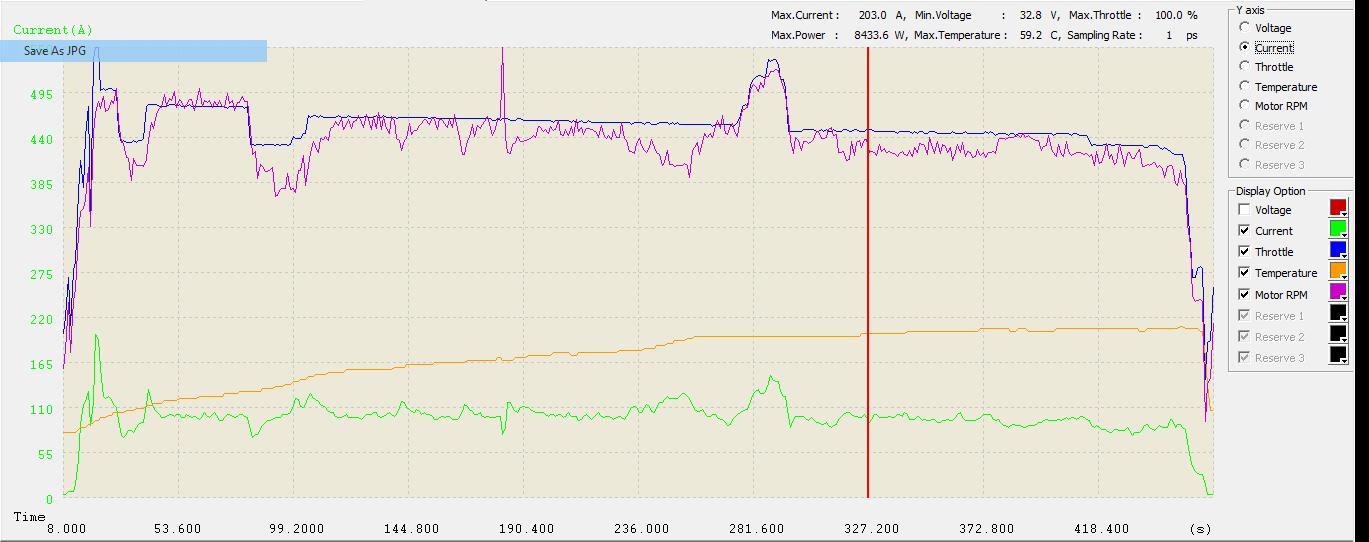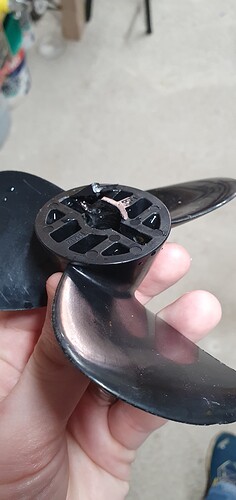I think one day David said ( flying rodeo )
« you don’t want me to design a prop that would burn your motor »
So I guess at some point his motor and the 65161 will not burn with that prop, especially for pics amp on start , to run it full power all time we already need a decent battery
May be @Flightjunkie can share is vesc settings used for top speed ?
This is my last and cleanest log from heifi esc no limits , smooth take off
Max power used was : 8400w
If you look at your log for take off either your battery amp x V or the motor amp x ( erpm /8 / 130kv ) you end up around 4500w
The FR can take more so 250A might be the setting needed to go past this 22000erpm and get some speed with your new board
That comment from David was in my build. I was kind of disappointed with the top speed of his new 6" prop with the new Flipsky motor (back in the days the 100kv was the only option). That was with 12S, also the common pack size. Nowadays I am running an 8" on this 100kv motor without any concerns. It could even handle 8.5" I guess.
By the way,in my build there is also a picture of a burned 65161 motor. It was used with a ridiculous prop with a regular esc. It burned on start. So yes, the motor can indeed burn if you do not have any limits
We need « high voltage » and low rpm for our prop so low kv motor and so thinner wire with more turn
Those can handle less current , the smart idea was to increase the size of the wire ( reducing the numbers of turns ) but by increase the nb of poles the kv is kept low as the FR motor and cooling increased as well
So if the 65151 can take some current load the FR can take at least 50% more
I have blown esc , lipo but no motor yet using decent props , weight was here but I had a long board so I cannot really compare
I think as long as it is well filled with mineral oil it should be pretty well cooled. Loves how it rides now, lot of grunt. Looking fw to receive the 7inch and folding prop
Increasing motor current did the trick. I’m easily getting up with the 850 now. Vesc seems happy, motor too
3 Likes
I had to do the 420A to get over the abs Overcurrent limit. Anyone figure out any reason why? I’d prefer it lower! Also blew my prop
when I changed the setting!
Good , 275A for 25k erpm on your last log that did the trick
25000/8/130*275= only 6600W …
275/ (130x2x3.14/60)= 21Nm if I am correct
Not sure I understand, can you elaborate on this ?
Also at 292A motor current I’d calculate the torque as following : (8.3 * 292) / 130 = 18.64 Nm.
270amp for start. That’s some serious numbers  I think the 65161 would melt on this
I think the 65161 would melt on this
Start by using the calculated flux value to reduce the sync issue
I think filled with mineral oil it would be ok. Did 220A often with the 120kv on first build
25000/8/130 is to calculate voltage applied
Ok thanks. Got you now.
However guys I am not sure this is the best way to calculate the voltage applied to the motor. Don’t forget the difference between the applied voltage and the rpm already.
Gona ask the Metr app guy if they could offer .csv export option. They should be able to get way more data like phase voltage ect.
I used a short cut , didn’t take in account back emf since it is hard to know with current control mode
1 Like
Sorry for resurrecting old thread, but I am desperate.
my setup: FR motor and prop (6 inch), Raiden 7, 14s12p 30Q, erayfoil remote and metr module.
No matter what I change in vesc tool, I can not solve my problem, which is: when bench testing my motor in 200L barrel of water, I am always drawing max motor current but without max rpm. started with 120A motor amps, now testing with 180A motor amps and still raiden is sending maximum 180A to motor with full throttle but not getting maximum rpm. (throttle on remote 100%, duty cycle in log 39-60% depending on max motor amps). Without active cooling, raiden is at 80 degrees in few secs. and I am talking about testing in barrel, so no wings, no my weight on board, just motor and water.
What I tried so far: few motor detections, both through automatic and manual detection, manually calculating flux linkage (almost the same number I get during motor detection), turning off phase filters, changing motor current (from 60A to 180A), changing from Current no reverse to Duty no reverse and doing input setup few times, changing remote from erayfoil to gt2b remote, changing throttle curve to expo… tested after each change and there is nothing I can do to fix behaviour of my setup.
@Manufoil seems like you had same problem but managed to solve it with increasing max motor amps to pretty high numbers, which doesn’t look like actual solution to me, more like bypass of a problem. or did you find in meantime real cause why you need such high currents?
latest metr log with 180A motor current:
What is the benefit of this Test? Just go in water and fly. 180amps should be enough. Can you reach full rpm in air? Static test is mich more amp consuming to get full throttle
Well first test was in water (100 motor amps) and I couldn’t get my board flying. First time riding such a small board (128cm) but after only few mins of trying to get it up I felt loss of power. Actually, it felt like there was never enough power to get it in the air.
Heatsinks were burning hot so I got thermal throttling - speed was too low for passive water cooling to cool down esc.
But if you say that it is so hard to get full throttle in static test, I will have to go back into water asap. And yes, I can get max rpm (95% duty cycle) in the air.
Things a really different in a barrel than on a board. In a barrel especially with a good prop which doesn’t slip you are going to load the motor like hell. This is why your motor current go to the roof without reaching high duty cycle. Riding you creat forward speed and as soon as you are on the foil the load on the motor decrease as the rpm increase, you will reach top rpm with lower motor current. Look at my logs, I need 200A motor current to take off as my board and wings I tiny and myself heavy… however at top speed Motor current is under 150A


 I think the 65161 would melt on this
I think the 65161 would melt on this